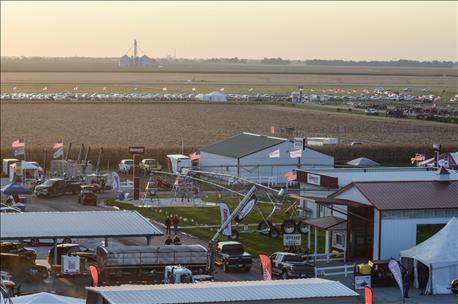
Whether it's visiting the state fair, field days and farm shows, or just getting the kids ready to go back to school, this is a busy time of year for farm families all across the U.S. For me, growing up in rural Iowa, August and the Iowa State Fair always meant one last hurrah before going back to the classroom.

LATEST AND GREATEST: You'll find plenty of the latest and greatest technology and equipment at the Farm Progress Show and Husker Harvest Days, but they’re also a good chance to learn about where the future of agriculture is heading through seeing new product launches and visiting with vendors.
However, as state fair season winds down, there are still two big events to attend before combines hit the fields during harvest season: the Farm Progress Show, held this year in Boone, Iowa, and Husker Harvest Days, held each year in Grand Island. I've always seen these two farm shows — ranked No. 1 on last year's Trade Show News Network Top 250 Trade Show List — as a kind of world's fair of agriculture.
So, here's a look at four ways FPS and HHD are the “World's Fair of Agriculture”:
1. See the latest and greatest on display. In the world's fairs of old, visitors from around the world were sure to see the latest and greatest technology had to offer. A key focus was to showcase the feats of industry, trade, society and culture, including cultural exchange and technological advances.
You'll find plenty of that at FPS and HHD, too. There's a good reason Jason Luebbe, host farmer at HHD, calls the new Diversified Industries East Tent that "Latest and Greatest Tent." Its tenants include precision ag vendors and technology — from unmanned aerial systems (UASs) to monitors to decision-making tools.
But it's not just about precision-ag tools. Both shows display the latest in equipment, including the new Tribine and Case IH's new autonomous concept, both big crowd-drawers at FPS last week.
2. Visitors come from across the nation and around the globe. World's fairs, although no longer held in the U.S., have traditionally drawn visitors from around the globe, and the same is true today for the fairs held overseas in places like Milan and Shanghai, which draw people from a number of different countries.
It's been a few years since I've walked the grounds at the Farm Progress Show, but any visitor will notice a significant international presence — many of which are international buyers. FPS hosts visitors from over 50 countries each year, and the show's International Visitor Center is a cornerstone at the event.
At Husker, you may not find as big of an international presence, but you'll find plenty of visitors and vendors from across the country, many from other states where irrigated agriculture and cattle are king.
3. It's a good place to see where the future of ag is heading. One of the main attractions at the 1939 New York World's Fair was the Futurama exhibit, where visitors could see a model of automobiles and network of expressways in a City of the Future. Likewise, more recent expos reflect current challenges and trends — for example, the 2015 Expo in Milan focused on feeding a hungry world.
Progress is a somewhat fluid concept by nature. It's evolving all the time, and our own perception of what progress and the future of agriculture looks like is ever-changing.
Take, for example, Case IH's autonomous concept unveiled at FPS. We've heard for several years now about the potential for autonomous agriculture. Sure, we've seen companies incorporate autonomous components into farm equipment for a few years now, but tractors that drive themselves will always draw a crowd. At these kinds of farm shows, growers can see concepts like this to get a feel for where agriculture is heading, and what autonomous systems of the future might look like.
4. It's an educational experience. Ever since the first world's fairs were held back in the 1800s, these events have been places to not only showcase the feats of modern society, but also learn about the latest accomplishments of science and technology.
Whatever you came to see at Husker Harvest Days, you're likely to walk away with some kind of new knowledge to take home to your farming or ranching operation — whether it's learning about improving your bottom line in your cow herd at a seminar in one of the cattle breed association tents, hearing market updates from Farm Futures Senior Grain Market Analyst Bryce Knorr in the Hospitality Tent, or visiting with an Extension educator or specialist at the University of Nebraska-Lincoln's Husker Red building on some of the latest nitrogen management or cover cropping practices.
Agriculture, probably more so than any other segment of society, is ever-changing. If you want a good look at just how far modern civilization has come, look no further than a farm show.
About the Author(s)
You May Also Like






